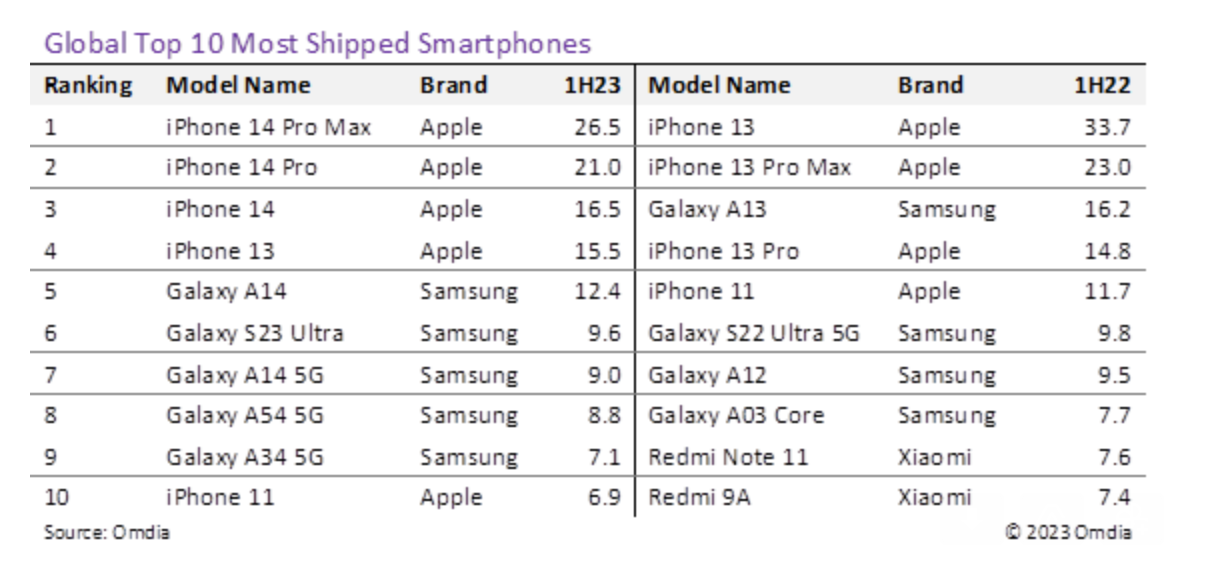

The iPhone 14 range dominated global smartphone demand for the first half of the year. according to Informa’s research arm Omdia.
Android phones will inevitably see another round of negative growth this year says the research firm the Omdia Smartphone Tracker reports.
The iPhone 14 Pro Max has been the most shipped smartphone worldwide in the first half of this year, with Apple shipping a total of 26.5 million units
Taking second place is the Apple iPhone 14 Pro with the iPhone 14 being the third 14 series model by Apple to enter the top 10 rankings for this quarter
Five Apple models were in the top 10, and Samsung smartphones occupied the remaining five. Among Samsung’s models, the Galaxy A14 recorded the highest shipment volume, which ranked 5th with 12.4 million units. Compared to last year’s Galaxy A13, which ranked third with 16.2 million shipments, both shipments and rankings decreased compared to the previous product.
Samsung’s premium model, the Galaxy S23 Ultra, retained the same ranking as last year’s Galaxy S22 Ultra 5G at sixth but saw total shipments decrease by 0.2 million units to 9.6 million units. The Galaxy A14 5G, A54 5G and A34 5G ranked at seven ,eight, and nine respectively.

Last year, two models of Xiaomi’s Redmi series entered the top 10 but failed to make it this year. This is because shipments of Chinese smartphone set makers have continued a double-digit decline since 2022 due to the slump in the mid-to low-end smartphone market, and shipments of individual models are also decreasing.
Comparing the top 10 models for the same period last year, shipments of the top-ranked model decreased by 7.2 million units for this year’s iPhone 14 Pro Max.
The iPhone 13 was last year’s top-selling model with a total of 33.7 million units shipped. However, when comparing the same lineup, the iPhone 13 Pro Max, which took second place last year, shipped 23 million units whereas its successor, the 14 Pro Max, shipped 3.5 million units more this year and rose in rankings by one notch. Shipments of the 14 Pro increased by 6.2 million units compared to its predecessor, the 13 Pro, and saw its ranking rise by two notches. However, comparing the standard 13 and 14 models, shipments of the 14 this year decreased by 17.2 million units compared to the 13.
“The global smartphone market is recording negative growth as the mid-to low-end market shrinks due to economic recession and the expansion of the used smartphone market,” says Omdia.
“The premium smartphone market is steadily increasing because replacement demand for Apple’s premium models remains solid. In addition, as the preference for Apple increases as a premium smartphone, especially within emerging markets, the sales volume and proportion of high-end models such as Pro and Max continue to increase among Apple’s iPhone series”
Omdia expects that global smartphone shipments will decline again this year. In particular.
“The slump in the mid- to low-end market is expected to continue into the second half of this year, and the increasing portion of the premium market is expected to continue in the second half of this year with the launch of the new iPhone 15 series. Therefore, shipments of Android-based smartphone OEMs, which have a high portion of mid- to low-priced smartphones, will inevitably see another round of negative growth this year.
“On the other hand, Apple’s shipments of Pro and Pro Max will increase due to solid demand for premium models, but overall iPhone shipments this year will be similar to last year or decrease slightly due to weak demand for standard and plus models”, said Jusy Hong, Senior Research Manager at Omdia.





